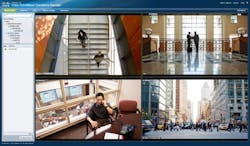Cisco upgrades its video solutions portfolio
Looking to build upon its strategy of being able to offer customers of all sizes a complete end-to-end security solution, IT communications giant Cisco this week unveiled several new additions to its line of video surveillance products, most notably the release of Video Surveillance Manager 7.0, the company’s newest video management software.
According to Guido Jouret, general manager emerging technologies and CTO at Cisco, VSM 7.0 is more than just a software update and represents the company’s efforts to develop a highly-scalable, user-intuitive video management platform.
"This is a complete new system we’ve been building for the last three years from the ground up," said Jouret in a videoconference with members of the media in briefing on Wednesday. "Our system is tested to support up to 10,000 cameras per server and we can scale that to 100,000 cameras by adding PSIM capabilities."
Jouret said that this increased scalability is absolutely essential as IT and security managers work together to reduce the strain that video places on the network. For example, one Cisco customer that was recently looking scale a system consisting of 3,400 cameras would have needed 17 racks and 200 server connections using solutions from another vendor. Cisco, however, was able to reduce that infrastructure down to just one rack and two server connections.
"Our unique approach to (video) is about scale, because nothing puts load on the network like video," Jouret said.
Two of the first end-users to deploy VSM 7.0, the Dallas County Tax Office in Texas and Elon University in N.C., raved about the capabilities the platform has provided them with.
Dallas County Tax Assessor John Ames said that the system has allowed the county, which is the second largest in the state and the ninth largest in the nation, to enhance the safety of citizens and workers at its offices and helped them meet their security goals.
"It has multiplied our security force and our police forces," said Christopher Fulkerson, assistant vice president for technology and CIO at Elon University. "It gives us eyes where we didn’t have them previously."
The company is also rolling out a new line of high-definition IP surveillance cameras featuring the company’s Medianet technology, which enables the automatic discovery and configuration of cameras on the network. In response to customer requests, Cisco has developed a Medianet Media Services Proxy, which will now allow for the automatic detection and configuration of third party cameras. The company will be featuring this new Medianet proxy in a plug-and-play demonstration next week in its booth at ASIS.
While Cisco is predominantly known for its products in the IT realm, Jouret said that they are increasingly becoming a video company and that the sector has become a multi-billion business for the firm. More and more, Jouret said that people are embracing video technology and deploying not just a few, but hundreds and even thousands of cameras at a time. This has brought about a demand in the market for the ability to virtualize video and make the network do more than simply record footage.
Personally, Jouret said he believed that future camera technology will feature more analytic capabilities that will help them "make sense of what they’re watching" and enable users to turn video into "actionable intelligence."
And while the current model in security has been to build a best-of-breed solution by mixing and matching technologies, Jouret said that there is a demand for complete end-to-end solutions from a single vendor who can be held accountable for the integration of the entire system on the network.
"Network integration sets us apart. We know what physical security looks like on the network," Jouret said.
That doesn’t mean, however, that a user has to tear out their entire infrastructure and start from scratch. Jouret compared the surveillance market to the phone businesses, which went through a similar migration.
"I wouldn’t say (users) have to rip out everything," Jouret added. "I think people are starting to realize you have to look at the total cost of ownership of a system. I believe what we’ve done with our system is provide total cost of ownership that is more effective and allows customers not to have to worry about how technology will work together."
About the Author
Joel Griffin
Editor-in-Chief, SecurityInfoWatch.com
Joel Griffin is the Editor-in-Chief of SecurityInfoWatch.com, a business-to-business news website published by Endeavor Business Media that covers all aspects of the physical security industry. Joel has covered the security industry since May 2008 when he first joined the site as assistant editor. Prior to SecurityInfoWatch, Joel worked as a staff reporter for two years at the Newton Citizen, a daily newspaper located in the suburban Atlanta city of Covington, Ga.

